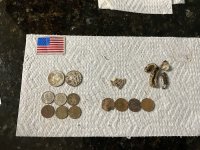2020hindsite
Jr. Member
Before reading understand that this is a slap in the face of commonality.
Please keep an open mind, I make no assumptions only observations and questions.
I have been prospecting for some time now and have read quite a bit on the subject. I sample and dredge and sluice and everything I can when I can.
I have located pay streaks and have believe myself to be average at reading a creek.
For the past few months I have been working a creek that has me convinced that there is no traditional pay streaks. I know that sounds crazy and goes against every book/video/etc. That I have encountered but then again not much information has been published on glacier placer mining. The creek I am working is at a moraine and I have never seen an easier place to find gold. Almost every pan has a color or two and there is copious amounts of black and garnet sand. The bottom is a mix of clay in some spots and broken slabs of bedrock in others. Underneath of the clay is nothing but tiny sea creatures and marine sand from the Ordovician period. No gold is associated with this era as far as I know and from testing.
So the bottom is broken slabs of dolostone and Pennsylvania limestone.
I stated earlier that it is very easy to find gold here I have not located what I would consider pay streaks. It seems as though there is a decently uniform distribution of gold in the hard packed cobble that lays just on top of the bedrocks/clay.
While you find gold every time you dredge I have not found greater values in 1 area compared to another.
It would be helpful to note that the gold is what Doc calls "dead presidents" gold meaning it was deposited thousand of years ago and hasn't moved. There is surface flood gold but it's fly poop sized and not worth trying to mine.
I have sampled a ton and followed indicator minerals and tried to follow traditional teachings relentlessly without success. I wonder if it is possible to have a creek without pay channels and more of a uniform distribution? I have gone as far as trying to picture the area thousands of years ago and even tried to picture the creek running the other direction as before the glaciers came to this area the waters ran south to north! Ice walls 2 miles high I'm sure did strange things is it possible not to have pay streaks?
If the creek does have them then is there such thing as a creek that breaks the rules?
Maybe I am too green after all of my efforts?
Your thoughts and advise.
Thank you
Please keep an open mind, I make no assumptions only observations and questions.
I have been prospecting for some time now and have read quite a bit on the subject. I sample and dredge and sluice and everything I can when I can.
I have located pay streaks and have believe myself to be average at reading a creek.
For the past few months I have been working a creek that has me convinced that there is no traditional pay streaks. I know that sounds crazy and goes against every book/video/etc. That I have encountered but then again not much information has been published on glacier placer mining. The creek I am working is at a moraine and I have never seen an easier place to find gold. Almost every pan has a color or two and there is copious amounts of black and garnet sand. The bottom is a mix of clay in some spots and broken slabs of bedrock in others. Underneath of the clay is nothing but tiny sea creatures and marine sand from the Ordovician period. No gold is associated with this era as far as I know and from testing.
So the bottom is broken slabs of dolostone and Pennsylvania limestone.
I stated earlier that it is very easy to find gold here I have not located what I would consider pay streaks. It seems as though there is a decently uniform distribution of gold in the hard packed cobble that lays just on top of the bedrocks/clay.
While you find gold every time you dredge I have not found greater values in 1 area compared to another.
It would be helpful to note that the gold is what Doc calls "dead presidents" gold meaning it was deposited thousand of years ago and hasn't moved. There is surface flood gold but it's fly poop sized and not worth trying to mine.
I have sampled a ton and followed indicator minerals and tried to follow traditional teachings relentlessly without success. I wonder if it is possible to have a creek without pay channels and more of a uniform distribution? I have gone as far as trying to picture the area thousands of years ago and even tried to picture the creek running the other direction as before the glaciers came to this area the waters ran south to north! Ice walls 2 miles high I'm sure did strange things is it possible not to have pay streaks?
If the creek does have them then is there such thing as a creek that breaks the rules?
Maybe I am too green after all of my efforts?
Your thoughts and advise.
Thank you
Upvote
0







